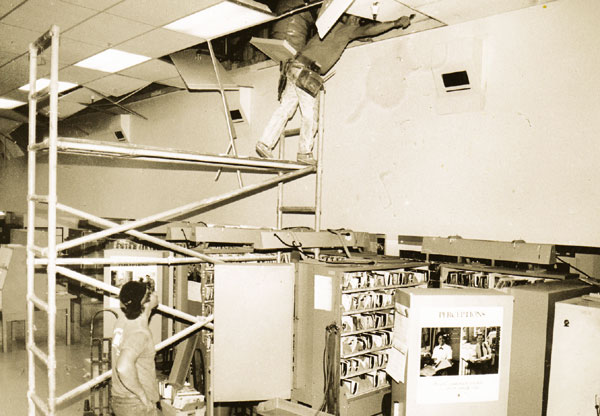Memories of fear and trepidation in response to the Loma Prieta
earthquake that shook Morgan Hill 20 years ago fade only to
amusement mixed with cautious relief and a heightened sensitivity
to what could happen next time, perhaps because of a lack of
serious local damage or injuries resulting from the largest Bay
Area disaster in recent history.
Memories of fear and trepidation in response to the Loma Prieta earthquake that shook Morgan Hill 20 years ago fade only to amusement mixed with cautious relief and a heightened sensitivity to what could happen next time, perhaps because of a lack of serious local damage or injuries resulting from the largest Bay Area disaster in recent history.
Somewhat ironically, Carol Agaliotis was already at Saint Louise Hospital in Morgan Hill when the earthquake shook the area, and fled hysterically to protect her infant adopted son.
Agaliotis had brought her son Alexander, now 21, to the emergency room the afternoon of Oct. 17, 1989 because he had been having seizures.
“My child was laying there on the emergency room bed, and the whole emergency room started shaking,” Agaliotis recalled earlier this week. “I picked him up, naked, and wrapped him up in a blanket. I remember being petrified with fear that this building would fall on us.”
The earth was still “rumbling” when she ran through the parking lot, and she fled so suddenly that she left her purse in the hospital.
Agaliotis immediately drove to her northwest Morgan Hill home to check on her other children. On her way up Llagas Road, she remembers glancing back at the valley floor and seeing a cloud of dust that had been shaken loose by the Bay Area’s most violent earthquake since the much more destructive San Francisco quake of 1906.
Although the 6.9-magnitude Loma Prieta temblor mostly spared Morgan Hill in terms of tangible loss of property, life and limb when it rocked the city Oct. 17, 1989, the rest of the Bay Area wasn’t so lucky. The cantilever section of the Bay Bridge connecting Oakland and San Francisco collapsed. The shaking wrecked San Francisco’s Marina district, and reduced multi-story buildings in Santa Cruz and Watsonville to rubble.
More than 60 people were killed by the shaking throughout the Bay Area, more than 3,000 were injured, and thousands more were left homeless. No deaths or injuries were reported in Morgan Hill.
Now a city councilman, Larry Carr was a student and water polo player at San Jose State University when the Loma Prieta quake happened. He said he was in the water during practice at the time.
“The lifeguards didn’t even let us change. We were asked to clear the pool, and we had to go home wearing our Speedos,” Carr said.
When he arrived home in Morgan Hill, a two-hour commute that day because of the lack of traffic signals and more vehicles on the road than usual, Carr didn’t notice a lot of damage. He said some items fell off shelves in his parents’ home, and electricity was out for at least a couple of days.
Morgan Hill City Councilman Greg Sellers’ life was transformed by the Loma Prieta earthquake. Like many Bay Area residents, Sellers was driving home – to Redwood City – when the earthquake hit at 5:04 p.m. He was eager to get home to watch the World Series, a matchup between Sellers’ beloved Oakland Athletics and the San Francisco Giants.
Because he was in a moving vehicle, Sellers said he couldn’t tell Interstate 280 was shaking underneath his “old AMC Rambler.” The car’s radio went off briefly, and when it came back on Sellers heard an announcement that a major earthquake had occurred.
Instead of stopping to watch the baseball game, which was canceled, Sellers continued south to Morgan Hill, where he grew up. His parents still lived in town, and he helped them clean up the damage.
While he was in town, he saw an opening for a job with the Morgan Hill Downtown Association. He applied for the job, which he was offered and subsequently accepted in December 1989.
“Kind of in a weird way, the earthquake was responsible for me moving back to Morgan Hill,” Sellers said.
Now serving on the city council, Sellers said he doesn’t recall much local damage resulting from the Loma Prieta quake. A temblor five years earlier caused more damage, in response to which city building inspectors red-tagged a list of commercial buildings downtown, Sellers said. He added that also in the aftermath of the 1984 quake, some downtown buildings such as the Votaw House, which Hot Java Coffee Shop and other businesses now occupy, and the Granary building undertook structural reinforcement projects.
Carr said the city is aware of the possibility of another Loma Prieta-sized or larger disaster, and ensures that city staff are well-trained to respond. City employees are also offered incentives to own homes and live in Morgan Hill, so they can quickly respond to local emergencies.
In response to the Loma Prieta quake, Santa Clara County upgraded its emergency operations center to a brand new facility. It also replaced the “really ancient” computers and other equipment that county responders used in Loma Prieta’s aftermath.
Brad Spencer was the chief of the now-defunct Morgan Hill Fire Department when the wave of shaking earth emanated from deep within the Santa Cruz Mountains to the west of Morgan Hill. He was still at the fire station, in his office, when the earthquake struck.
He remembers drawers on three filing cabinets being flung open by the shaking, scattering paper files all over the floor.
Spencer and other city officials immediately activated the city’s emergency operations center at Morgan Hill City Hall on Peak Avenue. Spencer said the only scenes of local earthquake damage he remembers are from the 1984 earthquake, when he was downtown and saw ground-floor windows blast out of buildings, and homes in the Jackson Oaks subdivision suffer heavy damage.
Locally, he said the Loma Prieta quake wasn’t significantly destructive. At his house on the western side of town, the only damage incurred was a broken glass that fell off a shelf.
Emergency services’ response to the 1989 disaster was not much different from training exercises they had conducted previously.
“It was like a real-time exercise, and perhaps that’s why it went so smoothly,” Spencer said. “It was a good lesson in being prepared.”
The Friendly Inn on Crest Avenue was designated as an emergency shelter for victims who might have lost their homes, but there was no need and “nobody showed up,” Spencer said.
The fire department’s response was methodical. Emergency services responded to calls that came through the EOC. Aware that some neighborhoods probably did not have phone service, crews started at the outer edges of town checking on residents, confirming that people were safe, working their way inward to City Hall.
The city’s fire department employed about 20 full-time firefighters. About 40 volunteers checked on their neighbors before checking in at the EOC, Spencer explained.
Now Morgan Hill has an entire facility adjacent to the police station devoted to use as an emergency operations center. Santa Clara County operates a web-based alert system that sends out instantaneous voicemail, e-mail and text messages to residents when there is an emergency.
“Everything shook into place,” Spencer said.








